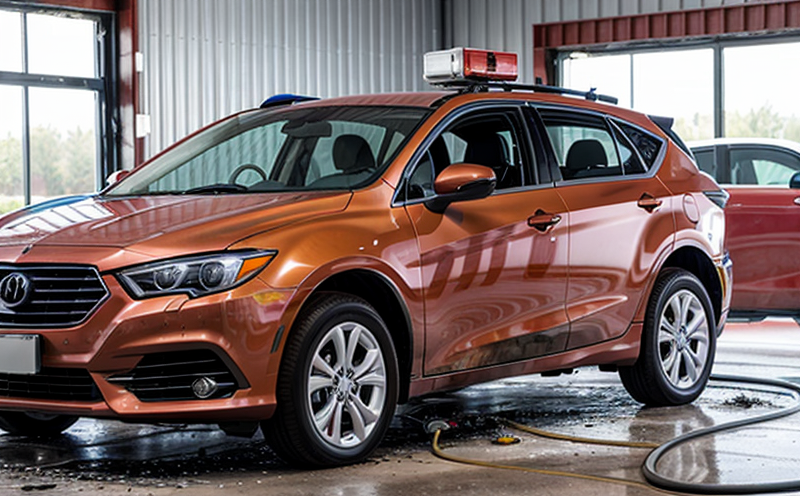ISO 5659-2 Smoke Generation Testing for Automotive Interiors
The ISO 5659-2 standard provides a comprehensive approach to evaluating smoke generation from automotive interiors under specified conditions. This service is crucial for manufacturers aiming to ensure the safety and compliance of their products with international standards.
Automotive interiors are exposed to various materials, including textiles, plastics, and foams, which can release harmful smoke constituents during fire incidents. The ISO 5659-2 standard focuses on quantifying these emissions, ensuring that vehicles meet stringent smoke density requirements before entering the market. This service is pivotal for compliance with global regulations such as those enforced by the National Highway Traffic Safety Administration (NHTSA) and the European Union's New Type Approval Regulation.
Testing involves exposing a representative specimen of the automotive interior to controlled combustion conditions in a specially designed chamber. The apparatus used includes an ignition source, smoke chamber, and measurement instruments like opacity meters or filter-based analyzers. Specimen preparation is critical; it requires accurate cutting according to the standard's specified dimensions.
The test procedure typically starts with preconditioning the specimen at specific humidity levels for defined durations. Ignition of the specimen in the chamber generates smoke, which is then measured using advanced optical techniques. The opacity or density of the generated smoke is quantified and compared against predefined acceptance criteria set forth by ISO 5659-2.
This testing not only aids manufacturers in identifying materials with superior fire resistance but also helps them to make informed decisions regarding material selection, thus enhancing overall vehicle safety. Compliance with this standard ensures that products meet stringent smoke density limits, contributing significantly to the reduction of post-accident inhalation risks for passengers and drivers.
The importance of ISO 5659-2 extends beyond mere compliance; it plays a key role in advancing fire safety technology by providing benchmarks against which new innovations can be evaluated. By adhering to these stringent testing protocols, manufacturers contribute to safer vehicles and potentially lower insurance premiums for consumers. Additionally, this service supports the broader automotive industry's commitment to sustainability through improved material choices.
To summarize, ISO 5659-2 smoke generation testing is a critical component in ensuring the safety and compliance of automotive interiors. It provides a robust framework for evaluating fire resistance properties, enabling manufacturers to make informed decisions that enhance vehicle safety while meeting regulatory requirements.
Benefits
The implementation of ISO 5659-2 smoke generation testing offers numerous benefits to organizations within the automotive sector. Primarily, it ensures compliance with international fire safety standards, thereby reducing the risk of accidents and enhancing overall vehicle safety. This service facilitates the development of safer materials that contribute positively to both human health and environmental sustainability.
From a regulatory perspective, adherence to ISO 5659-2 can help organizations avoid costly fines and penalties associated with non-compliance. Moreover, it positions them as leaders in fire safety technology, which is increasingly becoming a key differentiator in the competitive automotive industry. By adopting this standard, companies also gain access to global markets where stringent fire safety regulations are enforced.
On an operational level, ISO 5659-2 smoke generation testing streamlines the product development process by providing clear guidelines on material selection and design modifications necessary for meeting regulatory standards. This leads to reduced time-to-market for new products and enhanced brand reputation among consumers who prioritize safety features in their vehicles.
The testing also supports R&D efforts aimed at improving fire resistance properties of automotive interiors, encouraging innovation and technological advancement within the industry. By focusing on reducing harmful smoke emissions, this service contributes to a cleaner environment while promoting healthier lifestyles for vehicle occupants.
Environmental and Sustainability Contributions
Reduction in harmful smoke emissions during accidents can lead to improved air quality.
Enhanced safety measures contribute to lower healthcare costs related to fire incidents.
Innovation driven by ISO 5659-2 supports the development of greener materials and processes.
Increased awareness among consumers about safe vehicle design encourages more sustainable purchasing decisions.
The ISO 5659-2 smoke generation testing service plays a vital role in fostering environmental stewardship by promoting safer, cleaner, and more sustainable automotive interiors. By minimizing the release of harmful substances into the atmosphere during accidents, this standard contributes to better air quality and public health outcomes.
Competitive Advantage and Market Impact
The adoption of ISO 5659-2 smoke generation testing can significantly enhance a manufacturer's competitive position in the global automotive market. Compliance with this international standard signals commitment to safety and quality, which is highly valued by consumers worldwide.
Organizations that prioritize fire safety through rigorous testing like ISO 5659-2 are better positioned to attract business partners and investors who share similar values regarding sustainability and innovation. This can lead to expanded market reach and increased brand loyalty among environmentally conscious customers.
Moreover, the stringent nature of this standard encourages continuous improvement in product design and manufacturing processes. Companies that excel in meeting these high standards often receive recognition from industry bodies and regulatory authorities, further boosting their reputation and credibility.
The implementation also opens up opportunities for collaboration with other stakeholders involved in developing safer automotive interiors. These partnerships can drive research and development initiatives aimed at pushing boundaries in fire safety technology, ultimately leading to more advanced products that set new industry benchmarks.





